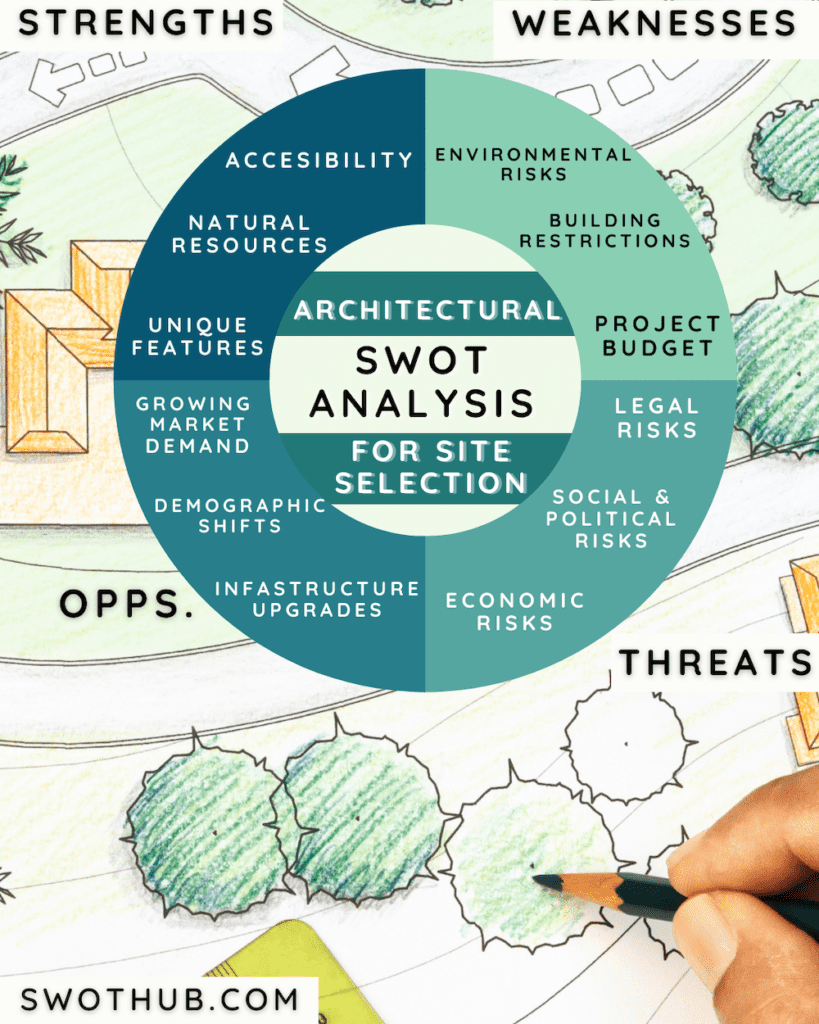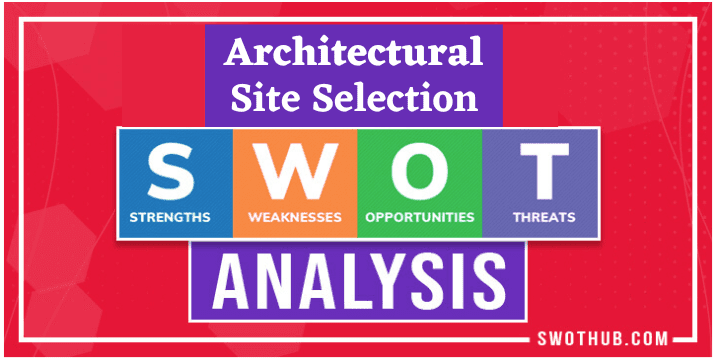If you’re an architect, architectural student, engineer, or design professional, understanding and conducting an architectural SWOT analysis can save you time, help solve design issues and more before you even start designing. Assessing the environment around the site, as well as the surrounding strengths, weaknesses, opportunities, and threats can be a worthwhile task. In this architectural SWOT analysis, we will show the benefits and the importance for you to know the risks and rewards before designing where your building will be built. If you are a stakeholder or investor in the design and/or construction of the building an architectural SWOT analysis for site selection can be essential.
Table of Contents
The Importance of Site Selection
How is SWOT Analysis used in Site Selection?
Conducting an architectural SWOT analysis is important for site selection because it helps evaluate the suitability of a location for a specific project based on the architectural aspects of the site. An architectural SWOT analysis can help identify the potential strengths and weaknesses of the site in terms of its design, construction, zoning regulations, and other factors that are essential for the successful completion of the project.
Some of the key benefits of using an architectural SWOT analysis for site selection include:
Better decision-making: By highlighting the site’s advantages and disadvantages, the analysis aids stakeholders in reaching wise judgments.
Reduced risks: The analysis helps to identify potential risks and challenges in the site selection process, which can help mitigate risks associated with the project.
Better resource allocation: The analysis helps to identify opportunities that can help maximize the use of available resources and optimize project outcomes.
Project outcomes are improved: In an architectural SWOT analysis helps to pinpoint opportunities and strengths that can be taken advantage of to achieve the best results possible.
The stakeholders who would benefit from the use of this architectural SWOT analysis include architectural students doing a site study, real estate developers, project managers, investors, and other stakeholders involved in the site selection process.
Architectural SWOT Analysis:
A SWOT analysis is a framework used to assess an industry, company, or in this case an architectural site plan to create a strategic plan. By taking architectural strengths, and weaknesses, and threats of the site plan as well as opportunities of the architectural site plan into account, we may better gain in-depth knowledge about the best way to proceed with the design. In this article, we’ll be taking a look at an architectural SWOT framework to better understand its usefulness for all stakeholders, designers, and students alike.
Architectural SWOT Analysis Strengths:
In an architectural SWOT analysis for site selection, strengths refer to the positive attributes of a location that can be leveraged to enhance the success of a project. Some of the strengths that can be identified in an architectural SWOT analysis include:
Accessibility: The site’s proximity to transportation networks, such as highways, airports, and public transportation, can be a significant strength.
Existing infrastructure: The presence of existing infrastructure, such as utilities, can reduce project costs and timelines.
Zoning regulations: Favorable zoning regulations can facilitate the project’s approval process and ensure compliance with local regulations.
Natural resources: Natural resources, such as water bodies or scenic views, can add value to the project and make it more attractive to potential customers or investors.
Historical significance: The site’s historical significance or architectural value can enhance the project’s branding and appeal.
Unique features: Unique features of the site, such as a notable landmark or distinctive architecture, can create a unique selling point for the project.
Identifying and leveraging these strengths can help optimize the project’s outcomes and ensure its long-term success.

Architectural SWOT Analysis Weaknesses:
In an architectural SWOT analysis for site selection, weaknesses refer to the negative attributes of a location that can hinder the success of a project. Some of the weaknesses that can be identified in an architectural SWOT analysis include:
Inadequate infrastructure: Project costs and completion times may be affected by a lack of vital infrastructure, such as utilities, roads, or internet access.
Environmental risks: The site may be at risk of natural disasters, such as flooding or earthquakes, or environmental hazards such as pollution, which can adversely affect the project.
Building restrictions: Zoning regulations or building codes may prohibit or limit the project’s design or development potential.
Competition: Other similar projects or businesses in the area can reduce the project’s market share or profitability.
High costs: The site’s real estate prices or construction costs may be high, making the project financially unfeasible.
Limited accessibility: The project’s success may be hampered by the site’s difficulty in being accessed by potential clients, suppliers, or workers.
Identifying these weaknesses can help stakeholders to develop strategies to mitigate their impact and reduce potential risks associated with the project.
Architectural SWOT Analysis Opportunities:
Opportunities are the external factors that can favorably affect the project’s success in an architectural SWOT analysis for site selection. In a SWOT analysis of architecture, some of the opportunities that can be found include:
Growing market: A growing market in the area can create a demand for the project’s services or products.
Economic incentives: The availability of economic incentives, such as tax breaks or grants, can reduce project costs and increase profitability.
Demographic shifts: The project may benefit from favorable demographic shifts like an expanding population or a change in consumer preferences.
Collaboration potential: The site’s proximity to other businesses or institutions can create opportunities for collaboration or partnerships.
Technological advancements: The availability of new technologies or innovations can enhance the project’s capabilities and competitiveness.
Infrastructure upgrades: The area’s planned or current infrastructure upgrades, such as new transportation networks or utility upgrades, can improve accessibility for the project and lower costs.
Identifying these opportunities can help stakeholders to develop strategies to leverage them to optimize the project’s outcomes and enhance its competitiveness.
Architectural SWOT Analysis Threats:
The external factors that may have a negative impact on the project’s success are referred to as threats in an architectural SWOT analysis for site selection. An architectural SWOT analysis can be used to identify various threats, such as:
Economic risks: Economic downturns, recessions, or fluctuations in interest or exchange rates can negatively impact the project’s profitability.
Legal risks: Changes in laws or regulations, or legal disputes, can increase project costs and timelines.
Environmental risks: Environmental disasters, such as floods, hurricanes, or wildfires, can damage the site or infrastructure and negatively impact the project’s success.
Competitive pressures: Intense competition from other businesses or projects in the area can reduce the project’s market share or profitability.
Social and political risks: Social unrest, political instability, or changes in government policies can negatively impact the project’s success.
Identifying these threats can help stakeholders to develop strategies to mitigate their impact and reduce potential risks associated with the project.
Architectural SWOT Analysis – Conclusion and Recommendations:
To ensure a thorough architectural SWOT analysis for site selection, the following recommendations can be given to the designer, stakeholders, and architectural design team:
- Conduct a comprehensive site analysis: A comprehensive site analysis involves gathering and analyzing a broad range of data related to the site’s physical, social, economic, and environmental characteristics. This analysis should be based on relevant standards, codes, and regulations, and should involve input from various stakeholders.
- Identify all stakeholders: All stakeholders, including the project owner, investors, local residents, and community leaders, should be identified and engaged in the site analysis process. This will ensure that all perspectives and concerns are taken into account.
- Develop a clear project brief: A clear project brief should be developed to ensure that the site analysis is aligned with the project’s goals and objectives. The brief should include a detailed description of the project’s scope, budget, and timeline.
- Conduct a thorough architectural SWOT analysis: A thorough SWOT analysis should be conducted to identify the strengths, weaknesses, opportunities, and threats associated with the site. This analysis should be based on relevant data and input from stakeholders.
- Consider sustainability and resilience: Sustainability and resilience should be key considerations in the site analysis process. This involves analyzing the site’s environmental impact, energy efficiency, and adaptability to climate change.
- Use technology and tools: Technology and tools, such as Geographic Information Systems (GIS) and Building Information Modeling (BIM), can be used to enhance the accuracy and efficiency of the site analysis process.
- Involve the design team early: The design team should be involved in the site analysis process from an early stage. This will ensure that the site analysis informs the design process and that the design is optimized for the site’s characteristics and constraints.
FAQs for Architectural SWOT Analysis
What is the purpose of conducting an architectural SWOT analysis for site selection?
It serves the purpose of assessing the strengths, weaknesses, opportunities, and threats associated with a potential site. This analysis helps stakeholders, designers, and teams make informed decisions by understanding the site’s attributes, potential challenges, and advantages for the successful execution of a project.
How does an architectural SWOT analysis impact the decision-making process for site selection?
It provides a structured framework for evaluating a site’s suitability. By identifying strengths, weaknesses, opportunities, and threats, decision-makers gain insights into how well a site aligns with project goals.
What role do stakeholders play in an architectural SWOT analysis for site selection?
Stakeholders, including project owners, investors, community members, and designers, play a crucial role. Their perspectives and expertise contribute to a comprehensive assessment of the site. Engaging stakeholders ensures that diverse viewpoints are considered, potential challenges are addressed, and the final site selection decision takes into account the interests of all parties involved.
By following these recommendations, the designer, stakeholders, and architectural design team can perform a thorough site analysis and develop a strong foundation for the successful delivery of the project.





